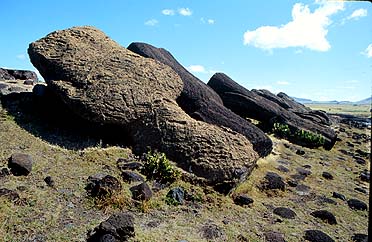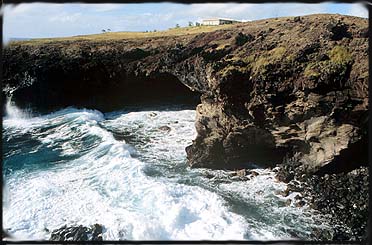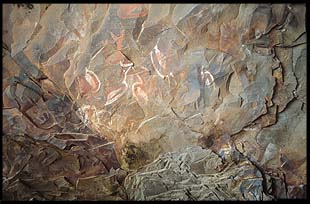 A
chilling story of resource exploitation and destruction is beginning to
come to light on Easter Island. The first westerners to discover the island
wondered how any one could have survived on such a desolate, treeless place.
Indeed, this was a mystery until recent core samples taken from the crater
lakes showed that the island was heavily forested with a giant extinct
palm while the Easter Island culture was active.
A
chilling story of resource exploitation and destruction is beginning to
come to light on Easter Island. The first westerners to discover the island
wondered how any one could have survived on such a desolate, treeless place.
Indeed, this was a mystery until recent core samples taken from the crater
lakes showed that the island was heavily forested with a giant extinct
palm while the Easter Island culture was active.
Apparently, the islanders were greeted with a lush tropical paradise when they first discovered it. It must have seemed inexhaustible. The trees were cut for lumber for housing, wood for fires, and eventually for the rollers and lever-like devices used to move and erect the Moai.

 The
violence grew worse and worse. It was said that the victors would eat their
dead enemies to gain strength. Bones found on the island show evidence
of this cannibalism. With the scare food supplies it may have been a question
of hunger as well as being ceremonial. A spooky cave of a (right) at the
southwest corner of the island, Ana Kai Tangata, is translated to "cave
where men are eaten." Inside are pictographs painted in ochre and white
of ghost like birds flying upwards. With no wood left to build boats, all
the Rapa Nui people could do was look enviously at the birds that sail
effortless through the sky. The Rapa Nui culture and community which had
developed over the past 300 years, collapsed.
The
violence grew worse and worse. It was said that the victors would eat their
dead enemies to gain strength. Bones found on the island show evidence
of this cannibalism. With the scare food supplies it may have been a question
of hunger as well as being ceremonial. A spooky cave of a (right) at the
southwest corner of the island, Ana Kai Tangata, is translated to "cave
where men are eaten." Inside are pictographs painted in ochre and white
of ghost like birds flying upwards. With no wood left to build boats, all
the Rapa Nui people could do was look enviously at the birds that sail
effortless through the sky. The Rapa Nui culture and community which had
developed over the past 300 years, collapsed.Their island was in shambles, and their villages and crops destroyed. There was no wood left on the island to build escape boats. The few survivors of the conflict, perhaps numbering as low as 750, began to pick up the pieces of their culture. One thing they left behind, however, were the Moai....

All rights reserved. Unauthorized copying and manipulation is prohibited.